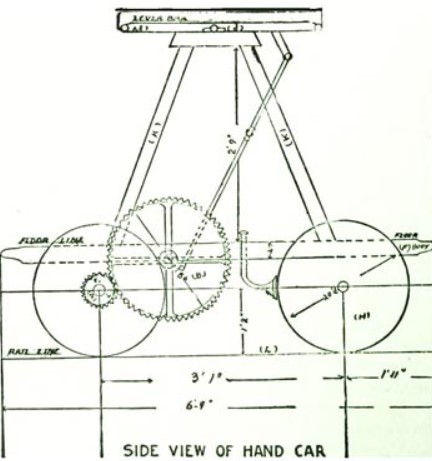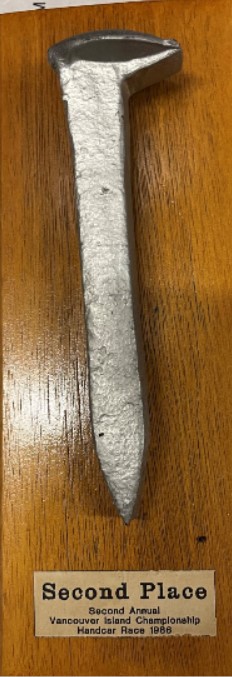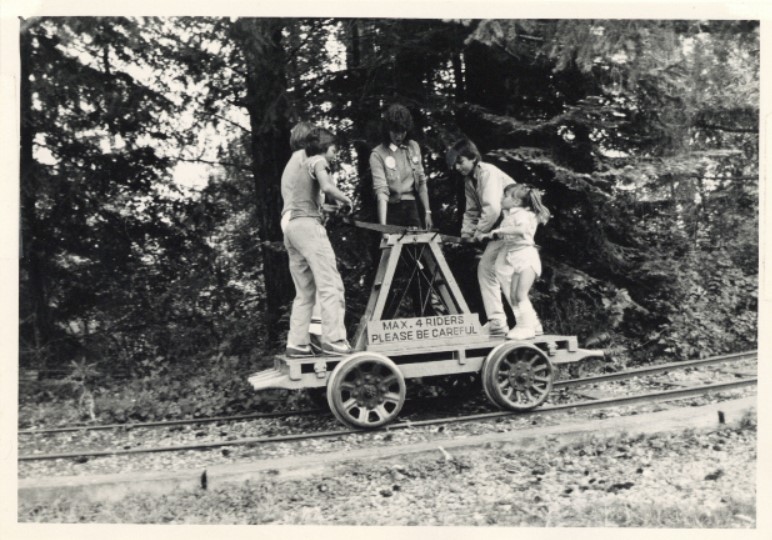
BCFDC Collection. 2023.019.909.
For those that visited the museum back when it was called the BC Forest Museum (BCFM), you may recall seeing a small contraption whizzing along the tracks powered by the excitement of riders. The handcar, sometimes called a pump car, was once a fast and fun attraction at the museum until it was deemed too dangerous for riders and was placed in storage. Although the handcar is no longer in use, it is fondly remembered by our volunteers, visitors, and community.
The history of the handcar begins in the 1860s when they first started appearing on railways for private companies. These early models had a hand crank that was spun, rather than pumped up and down like later models. In the 1880s, the hand car was commercialized and introduced to railways more widely, allowing more than two men to ride at once. While they were not an efficient mode of transportation in mountainous regions with more than a 2% grade, they were reliable and durable with minimal maintenance required.
The primary use of the handcar was for section gangs, which were groups of workers that maintained and repaired rail track in a set location. While working, the cars were loaded various with tools to use on the job, such as shovels, lanterns, spike hammers, files, hack saws, and more. The work of the section gang was hazardous, with many men killed from collisions with oncoming trains. The use of handcars quickly fell out of fashion in the early 1900s when the motorized speeder cars were introduced to railways. The speeders moved more men and equipment faster, with far fewer accidents.
The novelty of handcars lasted throughout the later half of the 20th century, with handcar races becoming increasingly popular in the 1980s and 1990s. This led to the development of better cars for competition. The newer design relied on a chain and sprocket to propel the car, as well as longer platforms that extended over the wheelbase. The novelty and excitement of riding the handcars was equally popular with visitors at the BC Forest Museum between 1964 and the 1990s. The founder of the museum, Gerry Wellburn, originally purchased the famed BCFM car from the Pacific Great Eastern Railway in 1960 from a man named Ernie Plante. The car remained in his possession for 4 years until the BCFM was built where his collection was transferred from his home in Deerholme.
The BC Forest Museum, like many other collectors of handcars, was swept up in the racing craze and participated in some of the local races throughout the 1980s. In 1986, the museum won second place at the Second Annual Vancouver Island Championship Handcar Race and has the trophy of the silver railroad spike that is pictured below in their permanent collection.

http://www.railroadhandcar.com/history/history.php

Some collectors still maintain and use handcars, with some updated safety features such as guardrails around the perimeter to prevent falls. Although the BCFDC no longer uses the handcar, visitors can see it on display in the Wellburn Building which is located on the lower grounds by the playground. The exhilarating thrill of hopping on a handcar will continue to live on in the memories of our visitors and in our collection. Some of these same visitors now bring their children to make new memories at the museum and at exciting weekend events, such as the Easter Eggspress which will be returning on April 8, 9, and 10.



